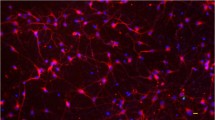Abstract
In vitro analyses of varicella zoster virus (VZV) reactivation from latency in human ganglia have been hampered by the inability to isolate virus by explantation or cocultivation techniques. Furthermore, attempts to study interaction of VZV with neurons in experimentally infected ganglion cells in vitro have been impaired by the presence of nonneuronal cells, which become productively infected and destroy the cultures. We have developed an in vitro model of VZV infection in which highly pure (>95 %) terminally differentiated human neurons derived from pluripotent stem cells were infected with VZV. At 2 weeks post-infection, infected neurons appeared healthy compared to VZV-infected human fetal lung fibroblasts (HFLs), which developed a cytopathic effect (CPE) within 1 week. Tissue culture medium from VZV-infected neurons did not produce a CPE in uninfected HFLs and did not contain PCR-amplifiable VZV DNA, but cocultivation of infected neurons with uninfected HFLs did produce a CPE. The nonproductively infected neurons contained multiple regions of the VZV genome, as well as transcripts and proteins corresponding to VZV immediate-early, early, and late genes. No markers of the apoptotic caspase cascade were detected in healthy-appearing VZV-infected neurons. VZV infection of highly pure terminally differentiated human neurons provides a unique in vitro system to study the VZV-neuronal relationship and the potential to investigate mechanisms of VZV reactivation.







Similar content being viewed by others
References
Baiker A, Fabel K, Cozzio A, Zerboni L, Fabel K, Sommer M, Uchida N, He D, Weissman I, Arvin AM (2004) Varicella-zoster virus infection of human neural cells in vivo. Proc Natl Acad Sci USA 101:10792–10797. doi:10.1073/pnas.0404016101
Christensen J, Steain M, Slobedman B, Abendroth A (2011) Differentiated neuroblastoma cells provide a highly efficient model for studies of productive varicella-zoster virus infection of neuronal cells. J Virol 85:8436–8442
Cohrs RJ, Wischer J, Essman C, Gilden DH (2002) Characterization of varicella-zoster virus gene 21 and 29 proteins in infected cells. J Virol 76:7228–7238. doi:10.1128/JVI.76.14.7228-7238.2002
Dukhovny A, Sloutskin A, Markus A, Yee MB, Kinchington PR, Goldstein RS (2012) Varicella-zoster virus infects human embryonic stem cell-derived neurons and neurospheres but not pluripotent embryonic stem cells or early progenitors. J Virol 86:3211–3218
Hood C, Cunningham AL, Slobedman B, Boadle RA, Abendroth A (2003) Varicella-zoster virus-infected human sensory neurons are resistant to apoptosis, yet human foreskin fibroblasts are susceptible: evidence for a cell-type-specific apoptotic response. J Virol 77:12852–12864. doi:10.1128/JVI.77.23.12852-12864
Gilden DH, Cohrs RJ, Mahalingam R (2003) Clinical and molecular pathogenesis of varicella virus infection. Viral Immunol 16:243–258
Gilden D, Mahalingam R, Nagel MA, Pugazhenthi S, Cohrs RJ (2011) Review: the neurobiology of varicella zoster virus infection. Neuropathol Appl Neurobiol 37:441–463. doi:10.1111/j.1365-2990.2011.01167
Gowrishankar K, Slobedman B, Cunningham AL, Miranda-Saksena M, Boadle RA, Abendroth A (2007) Productive varicella-zoster virus infection of cultured intact human ganglia. J Virol 81:6752–6756. doi:10.1128/JVI.02793-06
Mahalingam R, Wellish M, Cohrs RJ, Debrus S, Piette J, Rentier B, Gilden DH (1996) Expression of protein encoded by varicella-zoster virus open reading frame 63 in latently infected human ganglionic neurons. Proc Natl Acad Sci USA 93:2122–2124
Markus A, Grigoryan S, Sloutskin A, Yee MB, Zhu H, Yang IH, Thakor NV, Sarid R, Kinchington PR, Goldstein RS (2011) Varicella-zoster virus (VZV) infection of neurons derived from human embryonic stem cells: direct demonstration of axonal infection, transport of VZV, and productive neuronal infection. J Virol 85:6220–6233. doi:10.1128/JVI.02396-10
Padgett BL, Walker DL, ZuRhein GM, Eckroade RJ, Dessel BH (1971) Cultivation of papova-like virus from human brain with progressive multifocal leucoencephalopathy. Lancet 1:1257–1260
Payne FE, Baublis JV, Itabashi HH (1969) Isolation of measles virus from cell cultures of brain from a patient with subacute sclerosing panencephalitis. N Engl J Med 281:585–589
Plotkin SA, Stein S, Snyder M, Immesoete P (1977) Attempts to recover varicella virus from ganglia. Ann Neurol 2:249. doi:10.1002/ana.410020313
Pugazhenthi S, Nair S, Velmurugan K, Liang Q, Mahalingam R, Cohrs RJ, Nagel MA, Gilden D (2011) VZV infection of differentiated human neural stem cells. J Virol 85:6678–6686. doi:10.1128/JVI.00445-11
Wigdahl B, Rong BL, Kinney-Thomas E (1986) Varicella-zoster virus infection of human sensory neurons. Virology 152:384–399
Zerboni L, Ku CC, Jones CD, Zehnder JL, Arvin AM (2005) Varicella-zoster virus infection of human dorsal root ganglia in vivo. Proc Natl Acad Sci USA 102:6490–6495. doi:10.1073/pnas.0501045102
Acknowledgments
This work was supported by Public Health Service grants AG032958 (D.G. and R.J.C.) and AG006127 (D.G.) from the National Institutes of Health. Generation of VZV gH antibody was supported by grants EU FP6 INCO-CT-2006-026278 (CAPRI, S.J. and J.H.), EU FP7 REGPOT 229585 (CAPRI2010, S.J.), and the Bayerisches Staatsministerium für Wissenschaft, Forschung und Kunst (Baygene, J.H.). We thank Marina Hoffman for editorial review and Lori DePriest for manuscript preparation.
Author information
Authors and Affiliations
Corresponding author
Rights and permissions
About this article
Cite this article
Yu, X., Seitz, S., Pointon, T. et al. Varicella zoster virus infection of highly pure terminally differentiated human neurons. J. Neurovirol. 19, 75–81 (2013). https://doi.org/10.1007/s13365-012-0142-x
Received:
Revised:
Accepted:
Published:
Issue Date:
DOI: https://doi.org/10.1007/s13365-012-0142-x




